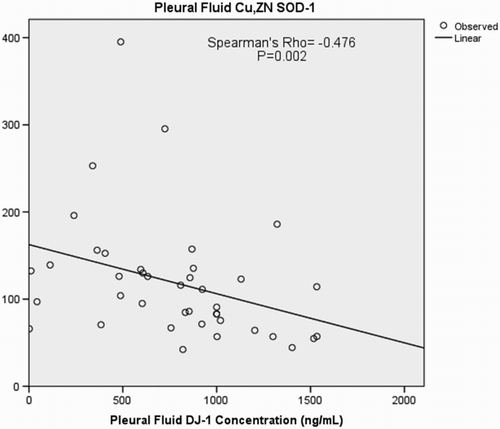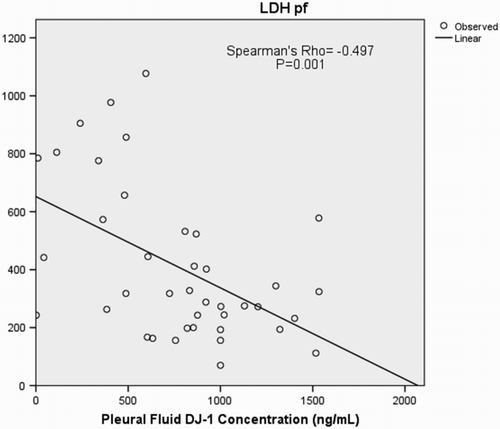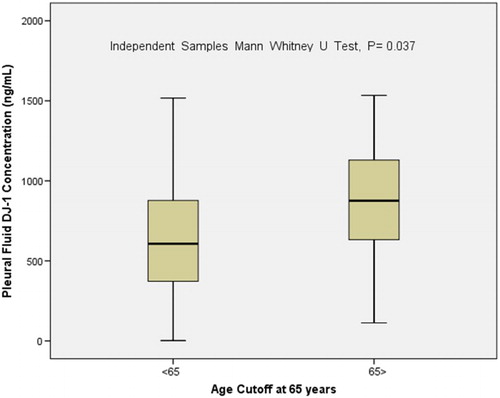Abstract
Objectives: DJ-1 is a multifunctional protein implicated in redox dependent cell fate decisions. The aim of our study was to determine the pleural fluid (PF) levels of DJ-1 in malignant pleural effusions (MPEs) secondary to lung cancer. Additionally, we opted to assess potential correlations of DJ-1 PF levels with the PF levels of superoxide dismutase-1 (SOD1) and 8-isoprostane that are known antioxidant enzymes and have been previously reported in MPEs.
Methods: Forty lung cancer patients with cytological proof of MPE were enrolled in this study. The PF levels of DJ-1, SOD1, and 8-isoprostane were measured by means of enzyme-linked immunosorbent assay.
Results: The median PF levels of DJ-1 were 826 ng/mL (interquartile range, IQR: 482–1010 ng/mL). DJ-1 PF levels significantly correlated with PF Cu/Zn-SOD1 and PF 8-isoprostane levels (Spearman's rho, r; r = −0.476, P = 0.002 and r = −0.264, P = 0.033, respectively), PF lactate dehydrogenase (r = −0.497, P = 0.001) and total PF cell counts (r = −0.325, P = 0.041). Finally, in patients aged over 65 the PF DJ-1 levels were significantly higher than patients aged less than 65 (875 ng/mL vs. 607 ng/mL, respectively, P = 0.037).
Discussion: To our knowledge, this is the first report to determine DJ-1's levels in MPEs due to lung cancer. The negative correlations between DJ-1, SOD1, and 8-isorpostane warrant further investigation regarding the altered redox regulation associated with MPEs.
Introduction
Lung cancer is a highly prevalent malignancy and a leading cause of cancer-attributed mortality worldwide.Citation1 Several studies have indicated that a perturbed antioxidant response is implicated in the pathophysiology of lung cancer.Citation2–Citation4 This dysregulation of redox homeostasis has been associated both with enhanced tumor invasiveness and poorer prognosis.Citation5
DJ-1 is a multifunctional protein involved in various cellular processes, including transcriptional regulation and redox homeostasis.Citation6,Citation7 In lung epithelial cells, these roles are exerted via the Nrf2/Keap1 pathway.Citation8 More specifically, DJ-1 stabilizes the antioxidant master regulator Nrf2 by preventing its binding to Keap1 and thus the subsequent ubiquitination of the resulting complex.Citation9
Many of DJ-1 functions' have been shown to be dependent on the specific redox status of C106, namely a conserved cysteine residue susceptible to oxidation.Citation10 Therefore, this protein may modulate cell fate decisions in direct response to increases in intracellular oxidative stress burden.Citation11
The physiological role of DJ-1 appears to be variably employed in cancer pathophysiology via a multitude of pathways.Citation12–Citation15 In lung cancer, DJ-1 has been found overexpressed in non-small-cell lung cancer tissue compared to healthy tissue.Citation16 Furthermore, the overexpression of DJ-1 has been reported to correlate with the development of cisplatin resistance in cancer cells,Citation17 as well as the increase in relapse incidenceCitation18 and the metastatic potential.Citation19 Despite its extensive involvement in the molecular processes intrinsic to lung cancer, DJ-1 has not been previously assessed as a pleural fluid (PF) or serum biomarker in lung cancer patients to date.
The measurements of DJ-1 levels have been previously investigated only in malignant pleural effusions (MPEs) secondary to metastatic serous ovarian carcinomas.Citation20 The expression of DJ-1 was increased in MPEs following chemotherapy, and was associated with lower progression free survival.Citation21 Although DJ-1 protects against oxidative stress, its levels have not been correlated with other oxidant and antioxidant indexes in MPEs, such as copper/zinc superoxide dismutase-1 (Cu/Zn-SOD1) or 8-isoprostane that have been found increased under inflammatory conditions.Citation22 Furthermore, DJ-1 has been previously shown to regulate SOD1's antioxidant activityCitation22; and may thus provide insight into the redox milieu of MPEs.
The aim of the present study was to determine the levels of DJ-1 in MPEs of lung cancer patients and to assess their potential correlations with standard PF biochemistry and oxidative stress indicators.
Materials and methods
Patients and samples
Forty patients, 21 males and 19 females, with a mean age of 65 ± 10 years and with previously untreated lung cancer (31 with non-small-cell lung cancer and 9 with small-cell lung cancer) whose MPEs were confirmed cytologically were enrolled in this study.
PF and peripheral blood samples were collected and a routine analysis of biochemical parameters was immediately performed. The routine PF analysis included protein, lactate dehydrogenase (LDH), glucose, total cell count, and pH measurements. Finally, an aliquot of the acquired PF was stored at −80°C until further analysis.
The study protocol and related procedures were approved by our Institutional Review Board. The patients included in our study were informed on the outline and all relevant study procedures prior to obtaining informed consent.
Measurements of DJ-1, Cu/Zn SOD1, and 8-isoprostane with enzyme-linked immunosorbent assay (ELISA)
The levels of DJ-1, Cu/Zn-SOD1, and 8-isoprostane in PF samples were evaluated by means of commercially available ELISA kits (CyLex, Japan; Biosource, Europe S.A.; and IBL International, Hamburg, Germany) according to the manufacturer instructions.
Statistical analysis
One-sample Kolmogorov–Smirnov was used to assess data distribution. Parametric data were expressed as mean ± SD; non-parametric data were expressed as median and interquartile ranges (IQR). Independent samples t test and independent samples Mann–Whitney-U test were employed to determine differences between the groups. Relationships were analyzed by the Spearman's rank correlation test, whereas associations were determined by linear regression. For all tests, a P-value of <0.05 was considered statistically significant.
Results
The median levels of DJ-1 in PF were 826 ng/mL (IQR: 482–1010 ng/mL). DJ-1's PF levels inversely correlated with PF levels of SOD1 (median 107.6, IQR: 70.8–135 ng/mL; Fig. ), PF levels of 8-isoprostane (median 24.3, IQR: 20.4–37.3 ng/mL; Fig. ), PF levels of LDH (median 416.7, IQR: 199–575 IU/L; Fig. ) as well as PF total cell count (median 1700, IQR: 1050–3430); Fig. ) shown in Table . DJ-1 PF levels were associated with SOD1 (R2 = 0.150, P = 0.022), 8-isoprostane (R2 = 0.113, P = 0.040), PF LDH (R2 = 0.292, P < 0.0001), and total cell count (R2 = 0.124, P = 0.032).
Figure 1 Scatter plot demonstrating the relationship between pleural fluid DJ-1 levels and SOD1 levels.

Figure 2 Scatter plot demonstrating the relationship between pleural fluid DJ-1 levels and 8-isoprostane levels.

Figure 4 Scatter plot demonstrating the relationship between pleural fluid DJ-1 levels and total cell count.

Table 1 DJ-1's correlations and associations
No statistically significant correlation was detected between the levels of DJ-1 and the differentials of the white blood cell (WBC) type detected in the PF. Finally, a very interesting finding was that in elderly patients, that is patients over 65 years, the levels of PF DJ-1 had significantly higher levels of DJ-1 compared to younger patients (median 875, IQR: 614.1–1010 ng/mL vs. median 607, IQR: 339.3–923.5 ng/mL, respectively, U = 271, P = 0.037; Fig. ).
Discussion
Our results have demonstrated statistically significant negative correlations between DJ-1 and markers of oxidative stress in pleural effusions due to lung cancer. Furthermore, DJ-1 was negatively correlated with other measured parameters of PF, such as LDH and total cell count. Interestingly, elder patients exhibit higher PF DJ-1 levels than younger ones.
Altered patterns of reactive oxygen species (ROS) detoxification as a pro-tumorigenic process have been the focus of several studies.Citation23 Among these, several of DJ-1's interactors have been specifically implicated in lung tumorigenesis, such as the Nrf2/Keap1 pathwayCitation24 and SOD1.Citation25 Interestingly, both SOD1 and DJ-1 have been shown to intertwine with the Nrf2/Keap1 pathway in oxidativestress.Citation26 The Nrf2/Keap1 pathway represents yet another example of the utilization of an oxidative stress response mechanism by neoplastic cells.Citation27 Our own results implicate both an upstream and downstream interactor (DJ-1 and SOD1, respectively) of this pathway in MPEs; consequently, further research should focus on the potential diagnostic and therapeutic role of the Nrf2/Keap1 pathway in MPEs. To our knowledge, no studies have assessed its contribution to date. DJ-1 upregulates SOD1's expression via the Erk1/2-Elk1 pathway as a response to oxidative insult.Citation28 Furthermore, both proteins have been shown to take part in the attenuation of metal-induced toxicity.Citation29 The inverse relationship between SOD1 and DJ-1 would appear confounding in this context, given that both proteins are found to be overexpressed in lung cancer cells.Citation30 One possible interpretation would be the formation of complexes between DJ-1 and SOD1, a cytoprotective process involving wild type DJ-1 and mutant SOD1.Citation31 An alternate hypothesis would consider the possibility of a feedback loop between DJ-1 and SOD1, one that would presumably contribute towards the homeostasis of the redox response mechanisms. This notion is further supported by the convergence of these two proteins in at least two separate pathways as we have previously mentioned, namely the Erk1/2-Elk1 and the Nrf2/Keap1 pathway. Both hypotheses however remain to be elucidated by further, more targeted studies.
LDH is a known marker of cellular membrane integrity.Citation32 The negative correlation we report could be attributed to DJ1's multiple interactions with pathways that promote the survival of neoplastic cells; In a similar manner, DJ-1's negative correlation with 8-isoprostane could reflect its pro-antioxidant role, by preventing ROS mediated lipid peroxidation. The negative relationship with total cell count however would also indicate that as DJ-1 may be secreted in PF from intact cells it could also be released from cells with compromised membrane integrity. A mechanism for extracellular DJ-1 secretion has indeed been proposed,Citation33 warranting more targeted evaluation of its significance in lung cancer.
Finally, we report that patients with lung cancer that develop MPE and are over 65 years of age exhibit higher PF levels of DJ-1. This is a novel finding and may relate to previous findings from our group showing that PF protein levels in a different clinical entity, complicated parapneumonic effusions, are inversely correlated with age.Citation34 As the alterations of PF physiology and pathophysiology with respect to age are scarcely studied this finding requires further investigation. Still its clinical value relates to the fact that in biomarker discovery age may have to be taken into account.
Though our study has addressed its initial aims, it was also presented with several limitations. As such, due to its preliminary nature, several prospective venues of research have arisen but currently fall beyond the scope of the current study; namely, the process of DJ-1 extracellular secretion as well as its association with aging. Finally, due to MPEs being the hallmark of advanced stage disease, any further research may not offer insight into the pathophysiological mechanisms related to earlier stages of lung cancer. However, the serum levels of DJ-1 could be evaluated towards this purpose instead.
Overall, we have detected and determined the levels of DJ-1 in MPEs due to lung cancer. Our findings raise several issues that warrant further investigation concerning DJ-1's role as an antioxidant in the pathophysiology of lung cancer derived MPEs. Finally, as our study was the first to assess DJ-1 from a redox regulation perspective in pleural effusions, future research should also aim to determine its levels and clinical significance in non-MPEs.
Disclaimer statements
Contributors None.
Funding None.
Conflicts of interest The authors state that there are no conflicts of interest.
Ethics approval This study has been approved by our Institutional Regulatory Board and our University's Committee of Ethics.
Acknowledgments
GV would like to thank Dr Nikolaos Nikolaou for his invaluable advice and support during the preparation of this manuscript, and Mr Pavlos-Christophoros Sinigalias for his invaluable contribution in logistics.
References
- Jemal A, Bray F, Center MM, Ferlay J, Ward E, Forman D. Global cancer statistics. CA Cancer J Clin 2011;61(2):69–90. doi: 10.3322/caac.20107.
- Kaynar H, Meral M, Turhan H, Keles M, Celik G, Akcay F. Glutathione peroxidase, glutathione-S-transferase, catalase, xanthine oxidase, Cu–Zn superoxide dismutase activities, total glutathione, nitric oxide, and malondialdehyde levels in erythrocytes of patients with small cell and non-small cell lung cancer. Cancer Lett 2005;227(2):133–9. doi: 10.1016/j.canlet.2004.12.005.
- Esme H, Cemek M, Sezer M, Saglam H, Demir A, Melek H, et al. High levels of oxidative stress in patients with advanced lung cancer. Respirology 2008;13(1):112–6. doi: 10.1111/j.1440-1843.2007.01212.x.
- Korkmaz GG, Inal BB, Ortakoylu GM, Irmak H, Kara AA, Gelisgen R, et al. Changes in oxidative stress parameters and antioxidant status in lung cancer: Western blot analysis of nitrotyrosine and protein carbonyls content. Clin Lab 2014;60(4):599–607.
- Lisboa da Motta L, Muller CB, De Bastiani MA, Behr GA, Franca FS, da Rocha RF, et al. Imbalance in redox status is associated with tumor aggressiveness and poor outcome in lung adenocarcinoma patients. J Cancer Res 2014;140(3):461–70. doi:10.1007/s00432-014-1586-6.
- Duan X, Kelsen SG, Merali S. Proteomic analysis of oxidative stress-responsive proteins in human pneumocytes: insight into the regulation of DJ-1 expression. J Proteome Res 2008;7(11):4955–61. doi: 10.1021/pr800295j.
- Yasuda T, Kaji Y, Agatsuma T, Niki T, Arisawa M, Shuto S, et al. DJ-1 cooperates with PYCR1 in cell protection against oxidative stress. Biochem Biophys Res Commun 2013;436(2):289–94. doi: 10.1016/j.bbrc.2013.05.095.
- Malhotra D, Thimmulappa R, Navas-Acien A, Sandford A, Elliott M, Singh A, et al. Decline in NRF2-regulated antioxidants in chronic obstructive pulmonary disease lungs due to loss of its positive regulator, DJ-1. Am J Respir Crit Care Med 2008;178(6):592–604. doi: 10.1164/rccm.200803-380OC.
- Clements CM, McNally RS, Conti BJ, Mak TW, Ting JP. DJ-1, a cancer- and Parkinson's disease-associated protein, stabilizes the antioxidant transcriptional master regulator Nrf2. Proc Natl Acad Sci USA 2006;103(41):15091–6. doi: 10.1073/pnas.0607260103.
- Wilson MA. The role of cysteine oxidation in DJ-1 function and dysfunction. Antioxid Redox Signal 2011;15(1):111–22. doi: 10.1089/ars.2010.3481.
- Waak J, Weber SS, Gorner K, Schall C, Ichijo H, Stehle T, et al. Oxidizable residues mediating protein stability and cytoprotective interaction of DJ-1 with apoptosis signal-regulating kinase 1. J Biol Chem 2009;284(21):14245–57. doi: 10.1074/jbc.M806902200.
- Zhu H, Liao SD, Shi JJ, Chang LL, Tong YG, Cao J, et al. DJ-1 mediates the resistance of cancer cells to dihydroartemisinin through reactive oxygen species removal. Free Radic Biol Med 2014;71:121–32. doi: 10.1016/j.freeradbiomed.2014.03.026.
- Zhu ZM, Li ZR, Huang Y, Yu HH, Huang XS, Yan YF, et al. DJ-1 is involved in the peritoneal metastasis of gastric cancer through activation of the Akt signaling pathway. Oncol Rep 2014;31(3):1489–97. doi:10.3892/or.2013.2961.
- Li Y, Cui J, Zhang CH, Yang DJ, Chen JH, Zan WH, et al. High-expression of DJ-1 and loss of PTEN associated with tumor metastasis and correlated with poor prognosis of gastric carcinoma. Int J Med Sci 2013;10(12):1689–97. doi: 10.7150/ijms.7292.
- Tsiaousidou A, Lambropoulou M, Chatzitheoklitos E, Tripsianis G, Tsompanidou C, Simopoulos C, et al. B7h4, HSP27 and DJ-1 molecular markers as prognostic factors in pancreatic cancer. Pancreatology 2013;13(6):564–9. doi: 10.1016/j.pan.2013.10.005.
- MacKeigan JP, Clements CM, Lich JD, Pope RM, Hod Y, Ting JP. Proteomic profiling drug-induced apoptosis in non-small cell lung carcinoma: identification of RS/DJ-1 and RhoGDIalpha. Cancer Res 2003;63(20):6928–34.
- Zeng HZ, Qu YQ, Zhang WJ, Xiu B, Deng AM, Liang AB. Proteomic analysis identified DJ-1 as a cisplatin resistant marker in non-small cell lung cancer. Int J Mol Sci 2011;12(6):3489–99. doi: 10.3390/ijms12063489.
- Kim RH, Peters M, Jang Y, Shi W, Pintilie M, Fletcher GC, et al. DJ-1, a novel regulator of the tumor suppressor PTEN. Cancer Cell 2005;7(3):263–73. doi: 10.1016/j.ccr.2005.02.010.
- Bai J, Guo C, Sun W, Li M, Meng X, Yu Y, et al. DJ-1 may contribute to metastasis of non-small cell lung cancer. Mol Biol Rep 2012;39(3):2697–703. doi: 10.1007/s11033-011-1024-7.
- Bunkholt Elstrand M, Dong HP, Odegaard E, Holth A, Elloul S, Reich R, et al. Mammalian target of rapamycin is a biomarker of poor survival in metastatic serous ovarian carcinoma. Hum Pathol 2010;41(6):794–804. doi: 10.1016/j.humpath.2009.09.017.
- Davidson B, Hadar R, Schlossberg A, Sternlicht T, Slipicevic A, Skrede M, et al. Expression and clinical role of DJ-1, a negative regulator of PTEN, in ovarian carcinoma. Hum Pathol 2008;39(1):87–95. doi: 10.1016/j.humpath.2007.05.014.
- Tsilioni I, Kostikas K, Kalomenidis I, Oikonomidi S, Tsolaki V, Minas M, et al. Diagnostic accuracy of biomarkers of oxidative stress in parapneumonic pleural effusions. Eur J Clin Invest 2011;41(4):349–56. doi: 10.1111/j.1365-2362.2010.02413.x.
- Hayes JD, McMahon M. NRF2 and KEAP1 mutations: permanent activation of an adaptive response in cancer. Trends Biochem Sci 2009;34(4):176–88. doi: 10.1016/j.tibs.2008.12.008.
- Ohta T, Iijima K, Miyamoto M, Nakahara I, Tanaka H, Ohtsuji M, et al. Loss of Keap1 function activates Nrf2 and provides advantages for lung cancer cell growth. Cancer Res 2008;68(5):1303–9. doi: 10.1158/0008-5472.CAN-07-5003.
- Glasauer A, Sena LA, Diebold LP, Mazar AP, Chandel NS. Targeting SOD1 reduces experimental non-small-cell lung cancer. J Clin Invest 2014;124(1):117–28. doi: 10.1172/JCI71714.
- Milani P, Ambrosi G, Gammoh O, Blandini F, Cereda C. SOD1 and DJ-1 converge at Nrf2 pathway: a clue for antioxidant therapeutic potential in neurodegeneration. Oxid Med Cell Longev 2013;2013:836760. doi: 10.1155/2013/836760.
- Lau A, Villeneuve NF, Sun Z, Wong PK, Zhang DD. Dual roles of Nrf2 in cancer. Pharmacol Res 2008;58(5–6):262–70. doi: 10.1016/j.phrs.2008.09.003.
- Wang Z, Liu J, Chen S, Wang Y, Cao L, Zhang Y, et al. DJ-1 modulates the expression of Cu/Zn-superoxide dismutase-1 through the Erk1/2-Elk1 pathway in neuroprotection. Ann Neurol 2011;70(4):591–9. doi: 10.1002/ana.22514.
- Bjorkblom B, Adilbayeva A, Maple-Grodem J, Piston D, Okvist M, Xu XM, et al. Parkinson disease protein DJ-1 binds metals and protects against metal-induced cytotoxicity. J Biol Chem 2013;288(31):22809–20. doi: 10.1074/jbc.M113.482091.
- Somwar R, Erdjument-Bromage H, Larsson E, Shum D, Lockwood WW, Yang G, et al. Superoxide dismutase 1 (SOD1) is a target for a small molecule identified in a screen for inhibitors of the growth of lung adenocarcinoma cell lines. Proc Natl Acad Sci USA 2011;108(39):16375–80. doi: 10.1073/pnas.1113554108.
- Yamashita S, Mori A, Kimura E, Mita S, Maeda Y, Hirano T, et al. DJ-1 forms complexes with mutant SOD1 and ameliorates its toxicity. J Neurochem 2010;113(4):860–70. doi: 10.1111/j.1471-4159.2010.06658.x.
- Allen CN, Gray TJ, Harpur ES, Hirst BH. Comparison of LDH. (51)Cr, and BCECF efflux as indices of non-steroidal anti-inflammatory drug-induced toxicity in human gastro-intestinal (HGT-1, HCT-8 and T84) cell lines: BCECF efflux is not an index of plasma membrane integrity. Toxicol In Vitro 1992;6(2):95–100. doi: 10.1016/0887-2333(92)90001-8.
- Tsuboi Y, Munemoto H, Ishikawa S, Matsumoto K, Iguchi-Ariga SM, Ariga H. DJ-1, a causative gene product of a familial form of Parkinson's disease, is secreted through microdomains. FEBS Lett 2008;582(17):2643–9. doi: 10.1016/j.febslet.2008.06.043.
- Zarogiannis SG, Tsilioni I, Hatzoglou C, Molyvdas PA, Gourgoulianis KI. Pleural fluid protein is inversely correlated with age in uncomplicated parapneumonic pleural effusions. Clin Biohem 2013;46(4–5):378–80. doi: 10.1016/j.clinbiochem.2012.11.024.


